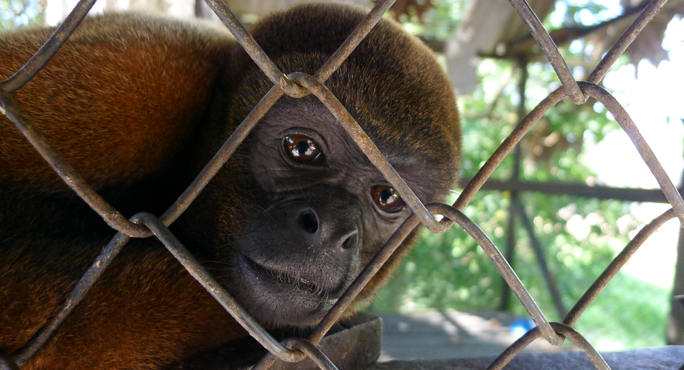Sad-eyed Monkey in Cage, Peruvian Amazon. Photo by Chris Kilham
A sad-eyed monkey in a cage frets nervously and moves back and forth, anxiety written in all its behavior. The pitiable creature is one of many in the “mini zoo” at the badly mis-described eco lodge Maloka.
At the end of a lane of raucous bars in the Yarinacocha district of Peru’s Amazon river city of Pucallpa, whose pounding disco music shakes the ground all night, Maloka is more Mad Max than Amazon. There you can have your disco, your shamanic ceremonies at night, a large buffet, and a shower, all within easy reach of vast swaths of human poverty and suffering. Welcome to what was once the greatest rainforest on earth, where savage destruction is the rule, where reason has long vacated the scene, and where devastation is simply the order of the day.
Most of the time I write these weekly articles from the comfort of my office in Massachusetts, but I am here in the Peruvian Amazon, and what I have witnessed over the past week or more is seared into my mind. In this chaotic and impoverished river city of Pucallpa, hundreds of thousands of displaced native people live in shabby neighborhoods without plumbing, where septic pools of stagnant water are filled with plastic bottles, disposable diapers, cans, and every type of filth and waste. The streets are choked with exhaust-spewing moto-taxis, the grit in the air stings your eyes, and children without futures play in dust and filth.
I am here working with Amazonian plants that demonstrate value for the cosmetic industry, and there are plenty to choose from. You have to go further out than ever before to get to forest, but there you can find natural treasures totally superior to the artificial chemicals, polymer beadlets, preservatives and petrochemical fragrances that comprise the majority of cosmetic products today.
To get to the native communities where we work, my friend Sergio and I travel many of the hundreds of Amazon rivers. As we go, we witness a steady parade of barges of old growth trees on their way to sawmills, to make planking. There is tremendous waste at the innumerable sawmills, whose discarded wood, in great mountains, burns day and night, sending plumes of smoke into the sky.
Yet consider the treasures being lost. Of the 80,000 or so higher plants estimated to exist in the Amazon, only three percent or so have been studied. Consider cat’s claw, an anti-inflammatory plant superior in every way to both ibuprofen and acetaminophen. The inner bark of an abundant vine, cat’s claw also demonstrates the ability to repair damaged DNA in skin tissue when applied topically. If a person has damaged their skin due to excess exposure to UVA and UVB rays of the sun, cat’s claw can help to repair the damage that has occurred.
There is dragon’s blood, the latex of a croton tree that is used for wound healing. With antibacterial, antiviral and antifungal properties, dragon’s blood is a superior first aid agent. But it is also a surprisingly effective skin-rejuvenating marvel, causing the formation of new, healthy collagen in skin when applied topically. Amazingly, only one half of one percent dragon’s blood in a cream or lotion will accomplish this.
While the global cosmetics industry has no natural black dyes of any kind, the super-abundant huito fruit colors hair a shiny black beautifully, and is used by virtually all Shipibo native people in the province of Ucayali. Producing a lustrous shine to hair, huito is unsurpassed as a natural black dye.
Dry or scaly skin responds beautifully to the silky vine oil that we have collected in the forest. In just seconds, skin hungrily takes it all in, resulting in a smooth appearance, and a reduction in fine wrinkles. These few ingredients are just the tiniest representation of the riches of the great Amazon rainforest.
Yet the Amazon is being cut down, burned down and otherwise destroyed at an accelerated rate. As many as 30 million animals and birds each year are taken for the exotic pet trade. Alligators and crocodiles have been largely wiped out to make shoes, belts and handbags. Where fish were abundant, drag-netting has drastically reduced their numbers.
Peru has deeded vast tracts of land to Chile, for de-forestation. Brazil is turning over immense acreage of forest to China for soybean cultivation. In the pillaging race, few scenarios compare to that of Amazonia, where small payoffs to the right officials can guarantee deforestation for decades.
Per acre, the land in the Amazon rainforest can yield far more profit from the sustainable harvesting of wild fruits, oil-bearing nuts and seeds, and medicinal plants, than from timber-cutting, cattle-grazing, or the cultivation of GMO soybeans. If profit is the main motive here, then forest preservation is the only viable path. But to establish programs that reduce devastation and promote genuine conservation, we need global awareness, immediate action, and less dithering at conferences far removed from the forest.
Every day when I am far enough out in the Amazon, either in virgin forest or far down one of the rivers, I marvel at the splendor of nature, and of its multiplicity of forms. When I hike under the verdant rainforest canopy, the green shade cools me as I catch a view of some rapidly-disappearing monkeys swinging in trees. Up some of the rivers, I spot pink fresh-water dolphins. The majesty of it is spellbinding. I hope I am not one of the last people to witness this, but reason tells me that the greatest rainforest on earth, with its beauty and beneficial treasures, is fading into the mists of time.


